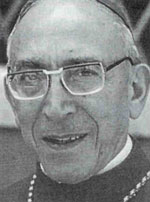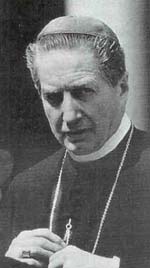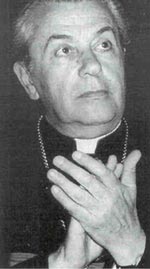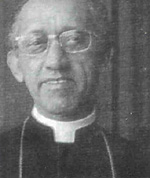SI SI NO NO NOVEMBER 1996 THE NEXT CONCLAVE AND ITS SECRETARY

November 1996 No. 18
Three things have recently happened which concern the next papal Conclave. At first glance they appear to be of little importance but we should think otherwise.
THE FIRST EVENT
The first happening is the publication of the book Le Successeur (Oct. 1995) by Giancarlo Zizola on the coming possible machinations in the election of Pope John Paul's successor. In reading it, one understands immediately why its author, a well-known "vaticanist," did not deem it prudent to publish his book in Rome. It would have been unappreciated by the Holy See to see coming from Rome a book which considers that Pope John Paul II, gravely ill, is at the end of his pontificate, and which gives the names of the "papable ones."
 Augustino Cardinal Casaroli |
Also in this book is a report on the role of the former Secretary of State, Card. Casaroli, in the preparation of the next Conclave. It is not coincidental that a long program devoted to the Cardinal aired on Italian television recently (Jan., 1996) or that he gave several interviews to various journals at that time. Looking ahead to the role which he could still play at the time of the Conclave, the Cardinal has judged it necessary to appear in a new light, washed of the stains of the Ostpolitik. He has done this by making Paul VI bear almost all the responsibility for it, especially that concerning the well-known case of the great Card. Mindszenty.
Some might think that the leaders of the power group so often discussed in Si Si No No are too old and no longer have a chance of success in the next Conclave, but it isn’t so. Earlier, it seemed that they would orient their choice towards a South American with pastoral and curial experience in order to have a candidate capable of rallying a large consensus, but this candidate [Msgr. Lucas Moriera Neves - Ed.] is “out of the race” given his health problems.
 Carlo Maria Cardinal Martini |
That leaves Card. Martini. Zizola devotes an entire chapter to him. Martini continues to publish books which invariably carry his photograph on the cover; he travels all over the world, giving conferences or preaching the “spiritual exercises.” His agenda is a full two years ahead. He is going out of his way to make himself known to a large part of the electors of the Sacred College.
It isn’t known if Zizola’s book was overseen by the liberal-radical wing of Card. Silvestrini, but it is certain that Zizola is an unconditional supporter of that wing. Si Si No No once reported:
Msgr. Silvestrini is not unaware of the power of the press. With the nomination of Navarro-Vals he has lost control of the official Vatican press bureau, but he continues to hold 'informal' meetings with the journalists on the premises of the Libreria Leoniana (owned by the Vatican) at 16-28 Via dei Corridori. [One can encounter there not only Silvestrini, but also Card. Pio Laghi, who drops in regularly to meet with Msgr. Gino Belleri, director of the Libreria and "chief" of this "parallel press bureau"]. This personal "press bureau" of Msgr. Silvestrini [and equally today of Laghi], whose first-hand news is evidently much sought after, is frequented by the most "progressist" of the "vaticanists" such as Giancarlo Zizola…. (Nov. 15, 1985)
THE SECOND EVENT
The second event is the important article by Vincenzo Card. Fagiolo, published in the 30 Day (Feb., 1995; Italian edition) entitled "Resignation of the Papacy and of the Episcopal Office." Card. Fagiolo, a noted canonist, concludes that "lack of health and strength" is a reason for resigning, a reason which finds "explanations within canonical tradition and the regular practice of the Church."
One must recall Card. Fagiolo's role at the time of the concordat between Rome and Italy which ultimately meant the de-Christianization of Italy. Card. Fagiolo not only contributed to the editing of the concordat, but he also was its great defender in the press (Il Tempo, Feb. 11, 1984; Feb. 19, 1984). In defending the concordat, he also defended those who were responsible for it: Casaroli and Silvestrini.
Why this article in 30 Days? Is this another of his strategies of defense? Does Fagiolo wish to present arguments in favor of the group which wants to prepare the next Conclave? To know a person, one must also know his friends. Let it be known that Card. Fagiolo is a close companion of Silvestrini and Virgilio Card. Noe, and without any doubt, he is the great defender of the work of Msgr. Bugnini, the principal demolisher of liturgical tradition.
THE THIRD EVENT
 Archille Cardinal Silvestrini |
The third happening is the Apostolic Constitution Universi Dominici Gregis (Feb., 22,1996). It seems to contain nothing new which could concern the proceedings of the Conclave. That was the opinion of the journalists who did nothing more than report what His Excellency Msgr. Jorge Maria Mejia had told them during the press conference at which the document was presented.
Moreover, as Secretary of the Sacred College, and thus of the next Conclave, Mejia was certainly the best informed person on all that could concern the election of the next pope. He said:
Thus, those who wish to seek out, or expect to find, substantial changes in the current compilation of the norms would be disappointed…. What are the changes...? They are, fundamentally, three small ones...(Osservatore Romano, Feb 24, 1996).
He specified them thusly: I) The Conclave fathers would reside in the newly prepared Domus Sanctae Marthae residence, not in the Apostolic Palace as in the past; 2) two traditional methods of election, by acclamation and by compromise, are now abolished; 3) special security measures have been mandated to insure the isolation and secrecy of the conclave proceedings.
However, that is not all that the text of the Pope's constitution says, and Mejia contradicts (by omission) what the Pope himself wrote:
I have esteemed it a duty to revise the very form of the election.
This really is an important change, the only substantial innovation in the constitution. Why did Mejia pass over it?
Here is the important change: If, after 30 votes (which, at four votes per day would mean on the eighth day) no one obtains two thirds of the votes...
...the Cardinal Electors shall be invited by the Camerlengo to express their opinion on the manner of proceeding, and the election will then proceed in accordance with what the absolute majority of them decides. Nevertheless, there can be no waiving of the requirement that a valid election takes place only by an absolute majority of the votes or else by voting only on the two names which, in the ballot immediately preceding, have received the greatest number of votes; and in this second case also, only an absolute majority is required. (Universi Dominici Gregis, #75).
 Lucas Morierea Cardinal Neves |
This is not a small change! This is changing a practice of more than eight centuries. The traditional two-thirds majority rule was fixed by the constitution Licet de Vitanda (1179) for several reasons: to have a candidate approved of by a large consensus, and, above all, to avoid any doubt about the election of the successor of Peter. If in fact the election is made by majority vote (as it will be now after 30 ballots), the new Pope could be elected with half of the votes plus one; and if there is one invalid, or dubious, or uncertain vote, his election will be null, or in doubt, or uncertain. One thus runs the risk of having two Popes and the risk of disputes which could even end up in schism. The change brought about by the recent apostolic constitution is then a very important one, one which could have incalculable consequences for the future of the Church.
In regards to this, Andrea Tornielli writes:
If this system had been in effect 18 years ago, perhaps John Paul II might not have been elected. It is known in fact that at the last conclave two candidates confronted one another, each vetoing the other's election…If the new rules had been in effect, it would not have been necessary to opt for a different candidate (one like Card. Wojtyla), able to attract a greater consensus from both sides. It would have been sufficient to wait, remaining steadfast in the positions of the first few days, ballot after ballot. Then, once the majority vote rule went into effect, one of the two... would have received the necessary plurality (Epoca, March 17, 1996). [The rival candidacies referred to were those of Cardinals Siri and Benelli.- Ed.]
AT THIS POINT, SI SI NO NO QUOTES THE FOLLOWING LETTER TO THE EDITOR FROM AN ARGENTINEAN PRIEST:
Dear Sir,
I am an Argentinean priest who very much enjoys reading your anti-modernist periodical. Occasionally you have spoken about the Church here in Argentina. Now I realize that we are not the center of the world, but I would like to bring home to you a few facts concerning the Argentinean clergy (sometimes considered as being conservative), especially now that recently it seems to have a certain role to play at Rome itself, as for example in matters concerning the nomination of bishops.
There exists in Argentina a group of liberal-radical bishops called the group of San Isidro [a diocese on the periphery of Buenos Aires from which they originated]. The group was strengthened and pushed to the fore from the time of Pio Laghi's arrival in Argentina as nuncio and it is now supported by Mejia.
These bishops are: Msgr. Carlos Galan, formerly auxiliary of Bishop Laguna at Moron, then Archbishop of La Plata; Msgr. Alberto Dovato, Bishop of Goya (now deceased); Msgr. Juan Rubon Martinez, Bishop of Reconquista; Msgr. Emilio Bianchi di Carcano, Bishop of Azul; Msgr. Alcides Jorge Casaretto, Bishop of San Isidro; Msgr. Fernando Maria Bargallo, Bishop of Moron.
Five of these bishops were nominated by Nuncio Pio Laghi. Among those, Bianchi di Carcano and Laguna had seen their candidacies for the episcopacy rejected by His Excellency Msgr. Lino Zanini, the nuncio in Argentina prior to Laghi. Laghi's behavior in these nominations was such that it caused some Argentinean priests to write reports about it to the Secretary of State.
It should have been hoped, with the departure of Laghi, that the group of San Isidro would gradually lose its prestige. (In fact, for fourteen years there has not been an episcopal nomination coming out of that group.) However, with the nomination of Mejia as Secretary of the Congregation of Bishops, the group has taken new life. Soon after the arrival of Mejia in Rome, Pargallo was named a bishop, and it is said that preparations are underway for two other promotions from the group, specifically those of Carlos Fronzini, Vicar General of San Isidro, and Alijandro Bunge, close friend and associate of Mejia.
Perhaps at Rome few know who Msgr. Mejia is….To us, Msgr. Mejia is known for his belonging to IDO-C [International Center for Documentation and Religious Information], an organization which defines itself as...:
...an international group independent of any religious institution whatsoever, open to all, and the members of which are selected democratically. The group concerns itself with collection and distribution of documentation on the structural and theological effects of the continuing application of the decrees and of the spirit of Vatican Council II. This information is not offered at the popular level, but rather at the level of the specialists. Among the subscribers one finds Catholic, Protestant, and Jewish students, as well as journals from all the different religious confessions. The group seeks to continue the "horizontal" communication brought to the fore by Vatican Council II, by putting into contact with one another all the members of the people of God and their opinions and ideas. To ensure this communication, IDO-C has organized a committee of 120 theologians.
Mejia was a member of the International Executive Committee of IDO-C and also a member of the Argentinean committee. The review Ya (Nov. 28, 1972) issued this item:
The Queriniana de Brescia will no longer print the review IDO-C Internazionale of the Center for Documentation and Religious Information founded during the Council…, the center whose positions are widely known to be in open disagreement with the Catholic hierarchy.
Mejia was also the director (1955-1977) of Criterio, a magazine of liberal propaganda.
He was also the artisan of the meeting at Assisi (1986), which he defended, by articles in Osservatore Romano. As a specialist in Judaism, he was Secretary for the Commission for Religious Relations with Judaism (1977 -1986) and it was he who organized the visit of the Pope to the synagogue of Rome.
I must say that, in Argentina, his nomination to the Congregation for Bishops was perplexing to a large number of priests; the more so because many remembered his iniquitous behavior towards a famous priest, who was also his teacher, Fr. Leonardo Castellani. Card. Quarrucino has encouraged reprinting Fr. Castellani's books…. In his Catechism for Adults, the Cardinal speaks of Mejia's unjust behavior against him [Fr. Castellani].
This is what I wanted to tell you, Father.
(Letter signed by an Argentinean priest)
Here are a few more bits of information on His Excellency Msgr. Mejia. He is a licentiate in Biblical Studies at the Pontifical Biblical Institute, that crucible of the present crisis, well known for its contempt of the constant magisterium of the Church. In Rome it is said that the nomination of Mejia as Secretary of the Congregation for Bishops was due to his old friendship with John Paul II, dating back to the time of the Pope's studies at the Angelicum. It seems that the "friendship" was dusted off and polished up in order to place Mejia in a position that he coveted. Mejia does in fact have some old friends in Rome, like Pia Card. Laghi and his friends in the group of Brisighella (Faenza), including Achille Card. Silvestrini, today Prefect of the Congregation for the Eastern Churches. Mejia knew Laghi when the latter was in Argentina, and Laghi prepared the way for Mejia's first appointment in Rome. Thus Mejia feels indebted to Laghi and he takes any occasion to thank him, as for example in the review he wrote for the book, Card. Pio Laghi: Honorary Citizen of Bethlehem, on the occasion of the Cardinal's 70th birthday. The wildly emotional eulogy that he made of this book is such that it casts doubt on the sincerity of the author's assertions.
Laghi, Silvestrini, and their companions certainly have the advantage of having a friend at the Congregation for Bishops. The Secretary of this Congregation plays a key role in the nomination of bishops. It is he who chooses the cardinal relator for every episcopal nomination. Who can prevent Mejia from naming Silvestrini, Laghi, Fagiolo, Poggi, Fumo, etc. as relators for the key posts?
In the article "Human Maneuvers in Preparation for the Next Conclave," we wrote:
[a]t the Conclave, one third of the cardinals is sufficient to defeat a candidate not "aligned" [to the power group] and thus to favor the election of the candidate desired [by the group] ...(Courrier de Rome, March, 1995).
Today it is even easier: one third of the cardinals, by voting as a bloc, can unleash the mechanism of the majority-vote rule. This will happen even more easily since the new residence of the electors in the Domus Sanctae Marthae no longer presents the inconveniences found at the Apostolic Palace which aggravated among the cardinals a certain haste to reach a conclusion.
We have illustrated three points of the strategy for the next Conclave. There is probably a fourth. There are rumors that there may soon be a consistory to create a small number of new cardinals. There are only a few posts vacant, but they are sufficient to reinforce an existing power group. Among the candidates for cardinal are: Msgr. Mejia, who aspires to succeed Card. Gantin, whose term expired a year ago. It would be an unusual event in the Curia for the Secretary to succeed the Prefect, but today anything is possible; Msgr. Marchisano, who characteristically does everything possible to obtain the cardinal's hat, benefiting from the same Piedmontese origin as the Secretary of State; Msgr. Dino Monduzzi who, even though suffering from Burger's disease, won't quit his post until he makes cardinal.
All these rumours are disquieting. Beyond the three events that we have related in this article (Zizola's book, Fagiolo's article in 30 Days, and the Apostolic Constitution Universi Dominici Gregis), is there perhaps more in the works?
Views: 100
Tags:
© 2025 Created by Dawn Marie.
Powered by
![]()
You need to be a member of Crusaders of the Immaculate Heart to add comments!
Join Crusaders of the Immaculate Heart